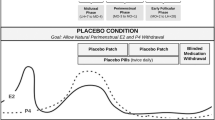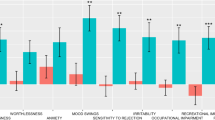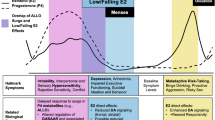Abstract
This study determined if women with premenstrual dysphoric disorder (PMS) showed impaired mood and performance when they were experiencing their premenstrual symptoms, and if the effects of alprazolam varied as a function of menstrual cycle phase. Under double-blind conditions, the acute effects of placebo and alprazolam (0.25, 0.50, 0.75 mg) were tested during both luteal and follicular phases. Women with confirmed PMS experienced substantial changes in mood as a function of menstrual cycle phase. However, under controlled laboratory conditions, acute doses of alprazolam did not improve negative premenstrual mood, but rather increased negative mood in the follicular phase. Alprazolam impaired task performance, although this impairment was generally similar in both phases when baseline phase differences were taken into consideration. Consistent with the failure of alprazolam to improve mood premenstrually, subjective measures indicative of abuse liability were not increased following alprazolam. Taken together, these data suggest that acute administration of alprazolam doses are not clinically useful for the treatment of PMS.
Similar content being viewed by others
Log in or create a free account to read this content
Gain free access to this article, as well as selected content from this journal and more on nature.com
or
References
American College of Obstetricians and Gynecologists (ACOG). (1989): Premenstrual syndrome. Committee Opinion, No. 66. Washington, DC: American College of Obstetricians and Gynecologists
American Psychiatric Association. (1994): Diagnostic and Statistical Manual of Mental Disorders, 4th ed. Washington, DC, U.S. Department of Health and Human Services
Aranko K, Matilla MJ, Bordignon D . (1985): Psychomotor effects of alprazolam and diazepam during acute and subacute treatment, and during the follow-up phase. Acta Pharmacol et Toxicol 56: 364–372
Bancroft J, Williamson L, Warner P, Rennie D, Smith SK . (1993): Perimenstrual complaints in women complaining of PMS, menorrhagia, and dysmenorrhea: Toward a dismantling of the premenstrual syndrome. Psychosom Med 55: 133–145
Barr S, Janelle KC, Prior JC . (1995): Energy intakes are higher during the luteal phase of ovulatory menstrual cycles. Am J Clin Nutr 61: 39–43
Beck AT, Ward CH, Mendelson M, Mock J, Erbaugh J . (1961): An inventory form measuring depression. Arch Gen Psychiatry 4: 561–571
Berger CP, Presser B . (1994): Alprazolam in the treatment of two subsamples of patients with late luteal phase dysphoric disorder: A double-blind, placebo-controlled crossover study. Obstet Gynecol 84: 379–385
Block RI, Berchou R . (1984): Alprazolam and lorazepam effects on memory acquisition and retrieval processes. Pharmacol Biochem Behav 20: 233–241
Christensen AP, Oei TP, Callan VJ . (1989): The relationship between premenstrual dysphoria and daily ratings dimensions. J Affect Disord 16: 127–132
Chutuape MD, de Wit H . (1995): Preferences for ethanol and diazepam in anxious individuals: An evaluation of the self-medication hypothesis. Psychopharmacology 121: 91–103
Ciraulo DA, Sands BF, Shader RI . (1988): Critical review of liability for benzodiazepine abuse among alcoholics. Am J Psychiatry 145: 1501–1506
Dennerstein L, Morse C, Burrows G, Brown J, Smith M . (1986): Alprazolam in the treatment of premenstrual syndrome. In Dennerstein L, Fraser I (eds), Hormones and Behaviour. Elsevier, pp 175–182
de Wit H, Griffiths RR . (1991): Testing the abuse liability of anxiolytic and hypnotic drugs in humans. Drug Alcohol Depend 28: 83–111
de Wit H, Pierri J, Johanson CE . (1989): Reinforcing and subjective effects of diazepam in nondrug-abusing volunteers. Pharmacol Biochem Behav 33: 205–213
DuPont EL . (1988): Abuse of benzodiazepines: The problems and the solutions. Am J Drug Alcohol Abuse 14(Suppl. 1):1–69
Endicott J, Nee J, Cohen J, Halbreich U . (1986): Premenstrual changes: Patterns and correlates of daily ratings. J Affect Disord 10: 127–135
Evans SM, Critchfield TS, Griffiths RR . (1991): Abuse liability assessment of sedative/anxiolytics: Rationale and laboratory lore. Br J Addiction 86: 1625–1632
Evans SM, Troisi JR II, Griffiths RR . (1994): Tandospirone and alprazolam: Comparison of behavioral effects and abuse liability in humans. J Pharmacol Exp Ther 271: 683–694
Evans SM, Foltin RW, Levin FR, Fischman MW . (1995): Behavioral and subjective effects of DN-2327 (Pazinaclone) and alprazolam in normal volunteers. Behav Pharmacol 6: 176–186
Evans SM, Griffiths RR, de Wit H . (1996): Preference for diazepam, but not buspirone, in moderate drinkers. Psychopharmacology 123: 154–163
First MB, Spitzer RL, Gibbon M, Williams JBW . (1995): Structured clinical interview for DSM-IV Axis I disorders- Patient Edition (SCID-I/P, version 2.0) Biometrics Research Department, New York, NY, New York State Psychiatric Institute
Freeman EW, Sondheimer SJ, Rickels K, Weinbaum P . (1985): PMS treatment approaches and progesterone therapy. Psychosomatics 26: 811–816
Freeman EW, Rickels K, Sondheimer SJ, Polansky M . (1995): A double-blind trial of oral progesterone, alprazolam, and placebo in the treatment of severe premenstrual syndrome. JAMA 274: 51–57
Halbreich U, Endicott J, Schacht S . (1982): Premenstrual syndromes: A new instrument for their assessment. J Psychiatr Treat Eval 4: 161–164
Harrison WM, Endicott J, Nee J . (1990): Treatment of premenstrual dysphoria with alprazolam: A controlled study. Arch Gen Psychiatry 47: 270–275
Iguchi MY, Handelsman L, Bickel WB, Griffiths RR . (1993): Benzodiazepine and sedative use/abuse by methadone maintenance clients. Drug Alcohol Depend 32: 257–266
Jensen BK . (1982): Menstrual cycle effects on task performance examined in the context of stress research. Acta Psychologica 50: 159–178
Kelly TH, Foltin RW, Emurian CS, Fischman MW . (1993): Performance-based testing for drugs of abuse: Dose and time profiles of marijuana, amphetamine, alcohol, and diazepam. J Anal Toxicol 17: 264–272
Keenan PA, Stern RA, Janowsky DS, Pedersen CA . (1992): Psychological aspects of premenstrual syndrome I: Cognition and memory. Psychoneuroendocrinology 17: 179–187
Keenan PA, Lindamer LA, Jong SK . (1995): Menstrual phase-independent retrieval deficit in women with PMS. Biol Psychiatry 38: 369–377
Linnoila M, Stapelton J, Lister R, Moss H, Lane E, Granger A, Eckardt MJ . (1990): Effects of single doses of alprazolam and diazepam, alone and in combination with ethanol, on psychomotor and cognitive performance and on autonomic nervous system reactivity in healthy volunteers. Eur J Clin Pharmacol 39: 21–28
Logue AM, Moos RH . (1986): Perimenstrual symptoms: Prevalence and risk factors. Psychosom Med 48: 388–414
McLeod D, Griffiths RR, Bigelow GE, Yingling J . (1982): An automated version of the digit symbol substitution test (DSST). Behav Res Methods Instrum 14: 463–466
McLeod DR, Foster GV, Hoehn-Saric R, Svikis DS, Hipsley PA . (1994): Family history of alcoholism in women with both generalized anxiety disorder and premenstrual syndrome: Patient reports of premenstrual alcohol consumption and premenstrual symptoms of anxiety. Alcohol Clin Exp Res 18: 664–670
McNair D, Lorr M, Droppleman LF . (1971): Profile of Mood States San Diego, Educational and Industrial Testing Services
Mello NK, Mendelson JH . (1985): Operant acquisition of marihuana by women. J Pharmacol Exp Ther 235: 162–171
Mello NK, Mendelson JH, Palmieri SL . (1987): Cigarette smoking by women: Interactions with alcohol use and menstrual cycle phase. Psychopharmacology 93: 8–15
Mello NK, Mendelson JH, Lex BW . (1990): Alcohol use and premenstrual symptoms in social drinkers. Psychopharmacology 101: 448–455
Metropolitan Life Insurance Company. (1983): Metropolitan height and weight tables. Statistical Bulletin Metropolitan Insurance Companies 64: 2–9
Miller TP, Taylor JL, Tinklenberg JR . (1988): A comparison of assessment techniques measuring the effects of methylphenidate, secobarbital, diazepam and diphenhydramine in abstinent alcoholics. Neuropsychobiology 19: 90–96
Morgan M, Rapkin AJ, D'Elia L, Reading A, Goldman L . (1996): Cognitive functioning in premenstrual syndrome. Obstet Gynecol 88: 961–966
Podolsky E . (1963): Women alcoholics and premenstrual tension. J Am Med Women Assoc 18: 816–818
Price WA, DiMarzio LR, Eckert JL . (1987): Correlation between PMS and alcoholism among women. Ohio State Med J 3: 201–202
Posthuma BW, Bass MH, Shelley BB, Nisker JA . (1987): Detecting changes in functional ability in women with premenstrual syndrome. Am J Obstet Gynecol 156: 275–278
Rapkin AJ, Chang LC, Reading AE . (1989): Mood and cognitive style in premenstrual syndrome. Obstet Gynecol 74: 644–649
Redei E, Freeman EW . (1995): Daily plasma estradiol and progesterone levels over the menstrual cycle and their relation to premenstrual symptoms. Psychoneuroendocrinology 20: 259–267
Resnick A, Perry W, Parry B, Mostofi N, Udell C . (1998): Neuropsychological performance across the menstrual cycle in women with and without premenstrual dysphoric disorder. Psychiatry Research 77: 147–158
Rickels K, Csanalosi I, Greisman P, Cohen D, Werblowsky J, Ross HA, Harris H . (1983): A controlled clinical trial of alprazolam for the treatment of anxiety. Am J Psychiatry 140: 82–85
Rivera-Tovar AD, Frank E . (1990): Late luteal phase dysphoric disorder in young women. Am J Psychiatry 147: 1634–1636
Schmidt PJ, Grover GN, Rubinow DR . (1993): Alprazolam in the treatment of premenstrual syndrome. Arch Gen Psych 50: 467–473
Smith S, Rinehart JS, Ruddock VE, Schiff I . (1987): Treatment of premenstrual syndrome with alprazolam: Results of a double-blind, placebo controlled, randomized cross over clinical trial. Obstet Gynecol 70: 37–42
Spielberger CD, Gorsuch RL, Lushene RE . (1970): STAI Manual for the State-Trait Anxiety Inventory (“Self-Evaluation Questionnaire”), Palo Alto, CA, Consulting Psychologists Press, Inc.
Sundström I, Ashbrook D, Bäckström T . (1997): Reduced benzodiazepine sensitivity in patients with premenstrual syndrome: A pilot study. Psychoneuroendocrinology 22: 25–38a
Sundström I, Nyberg S, Bäckström T . (1997): Patients with premenstrual syndrome have reduced sensitivity to midazolam compared to control subjects. Neuropsychopharmacology 17: 370–381b
Thorndike EL, Lorge I . (1944): The Teacher's Word Book of 30,000 Words Columbia University, NY, Teachers College
Weddington WW, Carney AC . (1987): Alprazolam abuse during methadone maintenance therapy. JAMA 257: 3363
Woods JH, Katz JL, Winger G . (1992): Benzodiazepines: Use, abuse, and consequences. Pharmacol Rev 44: 151–347
Acknowledgements
This research was supported by DA-03476 and DA-09114 from the National Institute on Drug Abuse, and approved by the New York State Psychiatric Institute-Columbia University Department of Psychiatry Institutional Review Board. The assistance of Dr. Jean Endicott, Eunice Dong, Christie Ieronimo, Shannon Miller, Jacqueline Schatz, and Grace Shiao is gratefully acknowledged. Portions of these data were presented to the Collegium Internationale Neuropsychopharmacologicumm in July 1996.
Author information
Authors and Affiliations
Corresponding author
Rights and permissions
About this article
Cite this article
Evans, S., Haney, M., Levin, F. et al. Mood and Performance Changes in Women with Premenstrual Dysphoric Disorder: Acute Effects of Alprazolam. Neuropsychopharmacol 19, 499–516 (1998). https://doi.org/10.1016/S0893-133X(98)00064-5
Received:
Revised:
Accepted:
Issue date:
DOI: https://doi.org/10.1016/S0893-133X(98)00064-5
Keywords
This article is cited by
-
Addictive behaviors across the menstrual cycle: a systematic review
Archives of Women's Mental Health (2021)
-
Opioid Antagonism of Cannabinoid Effects: Differences between Marijuana Smokers and Nonmarijuana Smokers
Neuropsychopharmacology (2007)
-
Dronabinol and marijuana in HIV+ marijuana smokers: acute effects on caloric intake and mood
Psychopharmacology (2005)



